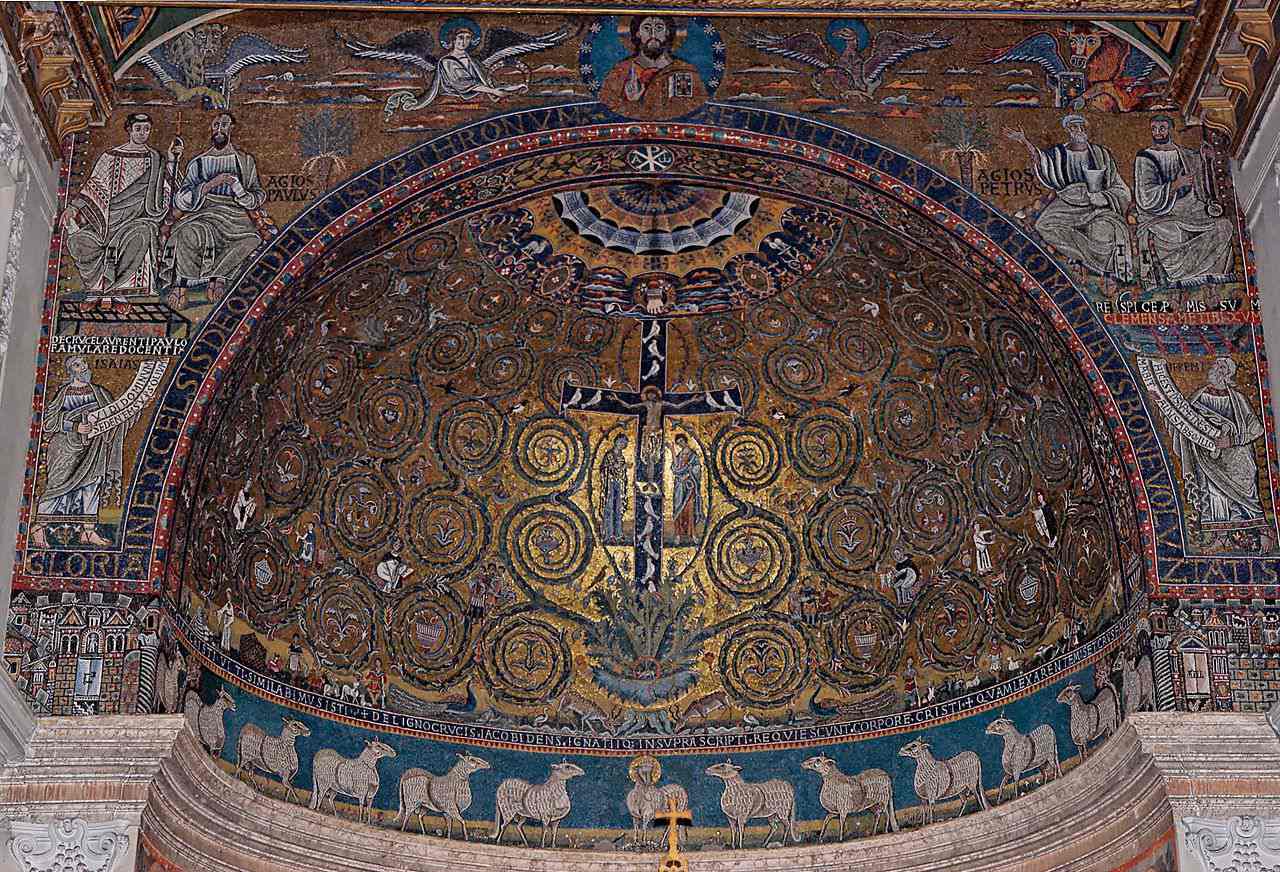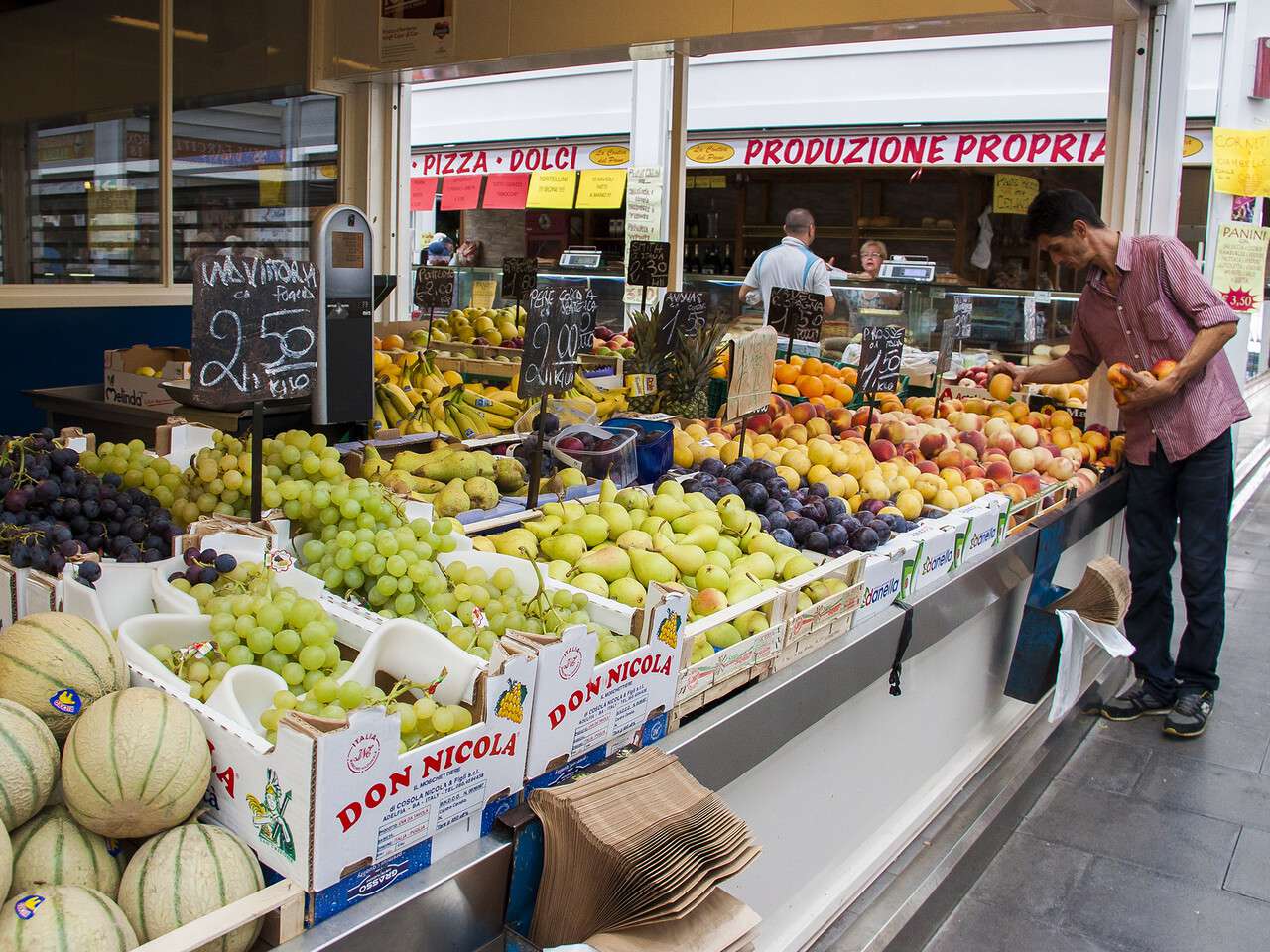Rome is famous for its amazing Colosseum, the Palatine, the Roman Forum and of course the Vatican. The trouble is everyone wants to visit. Instead, head for some fascinating archaeological museums and sites within and on the outskirts of Rome.
Here are ten off-the-beaten-track sites to explore in the Eternal City.
The Church of St. Clement

Apsis mosaic in the Basilica of San Clemente (c) Jastrow
The Church of St. Clement, located behind the Colosseum, in Via San Giovanni is a beautiful ancient basilica built in the Romanic style during the 12th under the pontificate of Pope Pascal II. Among the four distinct archaeological levels is a celebrated third-century Mithraeum and an early Christian basilica of the 4th century AD.
In the 19th century, excavations began beneath the basilica where the remains of a late-4th or early 5th-century basilica dedicated to Saint Clement were found.
The focal point is the mosaic with Christ on the Cross, depicted as the Tree of Life, from which flow the four rivers of paradise restored. Sprouting from an acanthus plant at the base of the Tree of Life are numerous vines, which nourish a breathtaking variety of images: birds, hinds, baskets filled with fruit, putti (pagan cupids), a shepherd with his sheep, a peasant woman feeding chickens, and the doctors of the Church.
The floor mosaic’s motif extends up the central aisle of the nave as if to extend the offer of paradise to all who enter.
Below is yet another layer of structures, some of which date back to the 1st century AD. Descending the staircase and crossing the three-level stratification beneath St. Clemen’s Church, you then go back in time to the 4th-century Basilica and to the even earlier remains of the well-preserved ancient cult of Mytra. You can hear the water flowing, as it did at that time, working its way down to the Tiber.
Beneath is an archaeological excavation site beneath St. Clement Church and the Roman Domus beneath the Church of Ss.Giovanni and Paolo on the Caelian Hill .
The Basilica of St. Giovanni

Interior of the Basilica of St. Giovanni and Paolo (c) Livioandronico2013
Visit the site of the Basilica of St. Giovanni and Paolo on the Caelian Hill by crossing via Celimontana. The Roman Domus beneath the basilica located in the fascinating scenery of the Clivius Scauri served as an ancient Roman road of the Caelian district. It contains the relics of the two martyrs and remarkable late Roman frescoes and a nymphaeum.
The Campus Martius
The Campus Martius, dedicated to the war god Mars, is where Roman soldiers played sports or exercised.
During imperial times the area, now the historic centre of Rome, is huddled between Venice Square, Navona square and Piazza del Popolo. Emperor Augustus used it for public entertainment and built theatres, baths, porticoes and temples there.
Start your walking tour from Via dell’Arco della Ciambella near Argentina Square and you can still see the ancient Baths of Agrippa.
Via della Palombella

Remains of the Basilica of Neptune (c) Carole Raddato
Continue towards the Pantheon square. Just before the square adjacent to the Pantheon rotunda look up at Via della Palombella to admire the magnificent ruins of the Basilica of Neptune. The basilica was constructed in 25 BC by Marco Vipsanio Agripp – son-in-law and admiral of the emperor Augustus – in honour of the sea god Neptune to celebrate his naval victory over Marc Antony and Cleopatra at Azio in 31 BC.
Then visit the imposing and well-preserved building of the Pantheon temple. It was transformed into the Church of Santa Maria ad Martyres during the VII century and then used as the opera house of the emperor Hadrian.
The Pantheon temple and the Piazza di Pietra

Ruins of the Temple of Hadrian (c) Nick Bramhall
The walk continues towards the beautiful Piazza di Pietra towards the ruins of the massive Temple of Hadrian. Emperor Antoninus Pius erected the temple in 145 AD in honour of the deified Hadrian.
In 1831 the building was assigned to the Borsa di Roma (the stock exchange of Rome). You can still see the 11 white marble Corinthian columns that reach 15 meters in height.
Piazza Colonna

The column of Marcus Aurelius
You can then walk towards Piazza Colonna. At the centre of the square just opposite the Chigi Palace, stands the column of Marcus Aurelius built to honour the emperor Marcus Aurelius by his son Commodus to celebrate his victorious campaigns against the German tribes of the Marcomanni, Sarmati and Quadi between 176 and 192 AD.
Then take a walk to Piazza Augusto Imperatore to visit the Mausoleum of Augustus, the great circular tomb of the emperor Augustus. The mausoleum was built by Augustus in 28 BC when he returned from Alessandria after the conquest of Egypt and the defeat of Marc Antony at Azio in 31 BC. When Augustus visited the Hellenistic tomb of Alexander the Great was inspired by its circular shape to build his own mausoleum.
Next head to the splendid marble altar of Peace built by emperor August in 9 BC to commemorate the safe return of Augustus after he had spent three years in Spain and Gaul. The altar is carved with mythological scenes depicting legendary figures such as Rome founders Romulus and Remus, the hero Aeneas, symbolic figures of the goddess Rome and the goddess Tellus. There is also a long frieze showing the procession of the imperial family to attend the altar sacrifice.
The Testaccio district

Testaccio Market: where Roman cuisine was born (c) My Italian Sketchbook
Another fascinating district of ancient Rome is the district Testaccio, located on the right shore of the Tiber river. The district is one of the most authentic neighbourhoods of Rome, rich in history and archaeological evidence. This is where “cucina romana” (Roman cuisine) was born and many restaurants offer a range of Roman dishes.
The was also the port of Ancient Rome, the “Emporium” and the busy commercial centre of Imperial Rome. Ancient warehouses such as the “Porticus Aemilia”, are still visibly hidden amid the streets and alleys of the district. An artificial mound, called “Monte Testaccio” was formed with the “testae”, fragments of broken amphorae dating from the time of the Roman Empire.
Finally, you can take a walk into the new market area to experience homemade Roman dishes prepared by the vendors of the many street food stands. Sample the delicious hand-cut ham and mozzarella di bufala balls from Enzo and Lina stand, the exquisite famed “panini” with boiled beef meat (alla picchiapò) and “trippa alla romana” from Sergios’s “Mordi and Vai” stand, the tasty Sicilian “cannoli” from “ Dess’ Art” of Costanza Fortuna and, for wine lovers, a glass of homemade genuine Italian wine from the popular Orazio’s stand is a must.
Some top museums

Sarcophagus of the Spouses from the collection at the National Etruscan Museum of Villa Giulia (c) Carole Raddato
If you have time there are remarkable museums that are worth visiting. The archaeological museum of Palazzo Massimo located in largo di villa Peretti near Termini station houses one of the most important collections of frescoes wall paintings and mosaics that originated from Roman villas. A stunning example is the wonderful triclinium of Livia, the wife of Augustus from the villa of Livia at Gallinas albas in Prima porta. It shows a magnificent garden with fruit trees and flowers, one of the most significant examples of Aguesten painting of the I century AD.
As well as a collection of Roman marbles there’s the splendid frescoes cycle of the villa Farnesina which belonged to the daughter of Augustus Giulia and her husband Agrippa.
The National Etruscan Museum of Villa Giulia tells of rituals of the Etruscan symposium of wine and its symbolic and religious meaning, uses and myths.
Many vases were imported from Greece. The painted images talk of myths and legends performed during the ceremony accompanied by the sound of an instrument in an atmosphere perfumed by incense.
Just outside Rome: ancient Ostia

Stunning site of ancient Ostia (c) Max Pixel
The stunning site of ancient Ostia, the port of ancient Rome is a little Pompei full of well-preserved monuments and private buildings that hint at the lively everyday life of its inhabitants. This includes Hadrian’s Villa, the splendid villa built by the emperor Hadrian at the foot of the hills of Tivoli and the sanctuary of Hercules Victor on the acropolis of Tivoli.
The famous sanctuary of the Fortuna Primigenia, located by the ancient Praenestae, (only about 30 km from Rome) is one of the most extraordinary examples of Roman sacred architecture. According to ancient sources, a natural grotto called the “Antro delle Sorti” (Cavern of the Fates) hosted the Oracle of the goddess Fortuna Primigenia who discerned the future from cryptic tablets (the so-called Sortes Praenestinae-Fates of Palestrina). A child descended into the dark of a deep bore, returning to light with an inscribed tablet with the “sors” (response) of the goddess.
Archaeological National Museum of the ancient Prenestae
The Archaeological National Museum of the ancient Prenestae is hosted in the adjacent historical seat of Palazzo Colonna Barberini. Here most of the archaeological finds were recovered in the territory of Palestrina the history and costumes of the ancient Roman town. The masterpiece of the collection is the famous “Mosaic of the Nile”.
Don’t want to go it alone: book a tour here
Source : https://www.thetravelmagazine.net/top-10-sites-in-rome-off-the-beaten-track/
